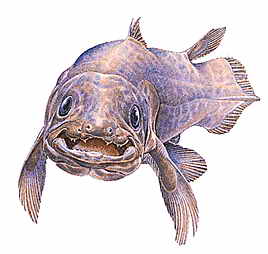Prehistoric monsters return to modern times
Now it is possible to catch a prehistoric fish, which became extinct millions of years ago
Driving along the coastline near Bonavista Cape (Newfoundland, Canada) Bob Crew saw something strange one fine morning. He stopped the truck to take a better look at a weird creature, which put its head out of water. The man thought at first that it was just a rock on the surface, but then it occurred to him that there were no rocks in the area. Then the man could see that the animal looked like a giant snake, its neck was about 1.5 meters long. The creature's head was crowned with a crest. Bob Crew could not remember any other details, but he was certain he had seen an extraordinary animal.
Citizens of the small Japanese town of Yoshii gathered for a real hunt in the summer of 2000. People wanted to trace and kill a mysterious creature that they nicknamed tsuchinoko. Local authorities promised a 20 million yen reward for capturing the animal. The creature was reminiscent of a giant lizard or a snake.  It could produce sounds like bird's chirping. Tsuchinoko mania gripped the Japanese town and its outskirts in May of 2000. It started when a farmer incidentally found a big snake crawling on his field. The man slashed the creature with a whip, but the monster escaped to the stream nearby. An elderly woman found the dead animal beside the same stream several days later. She decided to bury the animal. When local authorities learned about the strange incident, they ordered to exhume the animal's body and hand it over to a scientific institute. The professor examined the creature and concluded that it was most likely the animal often referred to as tsuchinoko, although it could be classified as a snake from the scientific point of view. Yet, the townspeople believed the story with the monster was not over. Another elderly woman saw tsuchinoko swimming along the river not far from her house. The snake had an unusual round snout.
It could produce sounds like bird's chirping. Tsuchinoko mania gripped the Japanese town and its outskirts in May of 2000. It started when a farmer incidentally found a big snake crawling on his field. The man slashed the creature with a whip, but the monster escaped to the stream nearby. An elderly woman found the dead animal beside the same stream several days later. She decided to bury the animal. When local authorities learned about the strange incident, they ordered to exhume the animal's body and hand it over to a scientific institute. The professor examined the creature and concluded that it was most likely the animal often referred to as tsuchinoko, although it could be classified as a snake from the scientific point of view. Yet, the townspeople believed the story with the monster was not over. Another elderly woman saw tsuchinoko swimming along the river not far from her house. The snake had an unusual round snout.
Giant snake in Arkansas
Reports about a giant snake eating domestic animals in the settlement of Foreman, Arkansas, appeared in July of 2000. A special environmental group failed to find the snake, although one could not deny its existence. The townspeople were certain a horrible creature was exterminating their animals. Several animals were found dead with lacerated wounds on their bodies. People said animals simply disappeared from homes. Cranes and herons left the local pond for soem unknown reason. The people, who eyewitnesses the monster, all said that it was a very big snake.
Wild cats in the States
The number of wild panthers and bobcats suddenly increased in several regions of Vermont and Wisconsin. Spokespeople for the environmental society had to talk to hundreds of eyewitnesses to find out the reasons of such an unusual phenomenon. People could see big black cats on roads and fields. The description was common among the majority of eyewitnesses: it was very strong cats, big-headed and long-tailed. About a dozen of people in Illinois saw a big puma hunting for a deer. A train hit a puma in Illinois in July. Scientists came to conclusion that it was a wild puma.
Coelacanths: the third advent
In 1938 fishermen caught a never-before-seen fish in Indonesian waters near the Comoro Islands. The 58-kilogram fish was caught at the depth of 75 meters. The incredible discovery instantly became a sensation in the zoological world. Scientists concluded the fish was a coelacanth – the last species of which became extinct millions of years ago. It is generally believed that a coelacanth was the first fish that appeared on land and started the evolution of Amphibians.
Another sensation took place in June of 1998, when another coelacanth was found not far from the Indonesian coast. Diver Pieter Venter found three coelacanths at the depth of 104 meters in October of 2000. Several months later he managed to film three coelacanths at the depth of 115 meters. The whole scientific world started talking about the third generation of the prehistoric fish. Some scientists believe it was the fourth discovery, though. They say two coelacanths were caught in 1995-1996. A member of Venter's team died during one of his dives. Another diver died in 1998 when he was chasing after a coelacanth.
Hairy elephants in Thailand
A lot of scientists traveled to the jungle of Thailand in December of 2001 to observe unusual elephants covered with fur like prehistoric mammoths. The animals were first photographed by Thai princess Rang. Several local residents came across the strange elephants too. Scientists were not sure that the photographed animals were mammoths, but they did not exclude such a possibility. Others simply ridiculed such an idea. Probably, the mysterious animals were simply baby-elephants, whose fur did not disappear. Little elephants are often born with thick fur on.
Subscribe to Pravda.Ru Telegram channel, Facebook, RSS!





